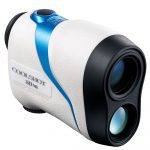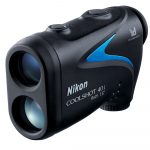As the saying goes, indeed, golf is a game of inches. Two different approach shots can land near the pin; one can spin backwards and finish near the hole, while the other can roll right past. Likewise, a ball can bounce firmly and end up out-of-bounds by a mere centimetre. Furthermore, guessing how far away the green is can cause golfers to use too much or too little club, turning a par into a bogey or worse. How do we take the guesswork out of measuring these distances? With a rangefinder – the 21st-century implement designed to bring ‘caddie’-style knowledge to the average golfer.
Here is what to look for in a new rangefinder:
Range
Probably the most important aspect of a rangefinder is the actual range it covers. A rangefinder is useful only if it can accurately read and pinpoint distance. They can vary in range; high-end models can be used from five to 1,500 metres with an accuracy of plus or minus one metre. Others may be accurate from shorter distances. Another advantage of a laser rangefinder is it can be used on the practice range to see how far you’re hitting each club.
Magnification
For optimal effectiveness, golfers should consider models with six times magnification. This can be very useful, not only for guiding the laser to get accurate measurements to the intended target, but also for locating landing areas. For example, from 175 metres away with the naked eye, it is impossible to locate a ridge on a green that should be avoided. Yet with a rangefinder, golfers can spot it easily and play safely away from it.
Quality
The quality of any optical device makes a big difference, so it is advisable to choose a brand with a solid reputation. Furthermore, the size of the lens (in millimetres, usually up to 27 millimetres) determines how much light comes through the lens and makes the unit easier to use, especially in low-light situations.
Convenience
Some golfers say certain rangefinders are too large for them to keep handy and use on every shot. A rangefinder’s battery type and battery life is also an important feature to consider. A dead rangefinder does a golfer no good. Also, consider ease of use. If a rangefinder is difficult to use, it becomes more of a distraction than an aid.
Advanced functions
Many golf rangefinders come with the function to also measure any change in elevation or other factors affecting a shot, such as temperature. At present under the Rules of Golf, these features are not permissible in competitive play, so make sure these functions can be enabled and disabled simply.
 Key features of the Coolshot series:
Key features of the Coolshot series:
• Continuous measurement function minimizes the influence of hand shake or movement.
• With VR (Vibration Reduction) system Reducing image vibration in the viewfinder enables you to hit the flagstick easily.
 • LOCKED ON Technology displays the distance to the closest subject, the flagstick, and the LOCKED ON sign in the viewfinder appears to inform you at the same time.
• LOCKED ON Technology displays the distance to the closest subject, the flagstick, and the LOCKED ON sign in the viewfinder appears to inform you at the same time.
• ID technology – Displays a guide distance to how far you should hit the ball, reading the uphill and downhill slopes of a course.
Available now from Nikon Australia MyNikonLife.com.au/store

